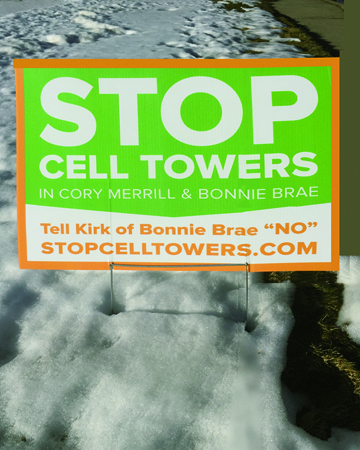
by Mark Smiley | Feb 29, 2016 | General Featured
Could Crash Home Values, Create Safety Concern
by Glen Richardson
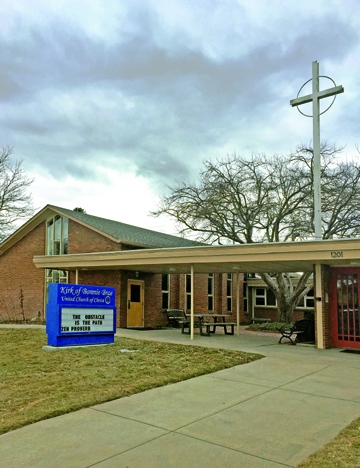
Homeowners in Denver’s Cory Merrill neighborhood are all charged up about Verizon Wireless putting up a 50-foot cell phone tower on the Kirk of Bonnie Brae Church property at 1201 S. Steele St. Verizon and the church are in negotiations to put the tower above a preschool and less than 20 feet from residences.
United in numbers, fuming homeowners in this neighborhood of winding streets and mature trees say it would lower property values and decrease school funding. Even more worrisome they say is that the church does not have a large enough property site to ensure a properly engineered “fall zone” for the tower. A fall zone is the necessary distance a tower needs to be from residences, schools and other structures should the tower collapse. Minimally the distance is considered to be 110% of the height of the tower, or in the case of Kirk of Bonnie Brae a setback of 55 feet.
Area residences point out that if constructed the tower’s setback at Kirk wouldn’t be close. “It would sit within 10 feet of existing power lines and an alley, 20 feet from adjacent homes, the day care center and church. Everything and everyone living and working within a 55 foot distance from the tower will be at risk,” they warn. Furthermore, they articulate that in the event of an accident Steele St. and Arizona would be blocked, inhibiting first responders and impacting evacuation routes.
What’s At Stake?
Developed in the 1940s and ’50s, homes in Cory Merrill range from small but unique original houses, to multi-million dollar custom built dwellings. The neighborhood is east of University, North of I-25, West of Colorado Blvd. and South of Mississippi. Kirk of Bonnie Brae was founded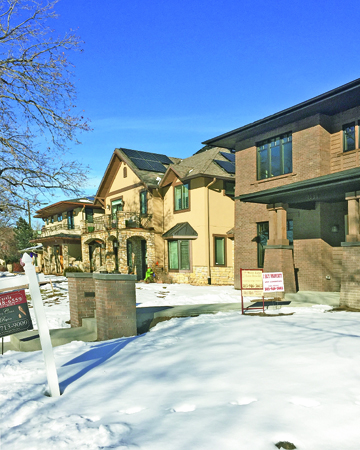 as a Congregational Church in 1947 and is affiliated with the United Church of Christ, a mainline Protestant denomination. The name Kirk is the Scottish word for Church, fitting for the neighborhood whose name also has Scottish origin (Bonnie Brae means beautiful hill).
as a Congregational Church in 1947 and is affiliated with the United Church of Christ, a mainline Protestant denomination. The name Kirk is the Scottish word for Church, fitting for the neighborhood whose name also has Scottish origin (Bonnie Brae means beautiful hill).
Current real estate studies show that proximity to cell towers reduces the value of a home by 20.7% to 21%. Approximately 130 homes were sold in the Cory Merrill neighborhood within the last 12 months. Furthermore, real estate values have appreciated 4.1% since Feb. 2015. Prices for homes ranged from $286,900 (least expensive) to $1,633,000 (most expensive). Neighborhood leaders say they are concerned that, “The ability to build any real increase in value within the neighborhood would be irreparably harmed.”
Verizon says the area is in need of a new wireless tower site, “based on zoning areas and how it will affect the area network, and would enhance coverage in the neighborhood.” The tower would be a 50-foot canister pole that would look like a flagpole and house all wiring and antennas inside a 4 ft. x 4 ft. footprint. Verizon also admits it could do a “monopine” design (that would make it look like a tree) but suggests, “The light pole design would work better and better integrate into the neighborhood and environment.” Verizon also has an option to add other carriers to the tower if they are approached. Construction could start as early as March-April and would take approximately 90 days.
Residents Speak Up
Once again it’s business as usual in Denver, suggests resident George Mayl who lives on South Garfield St. “Tear down this to build bigger and bigger. Let’s place a 50 ft. monolith smack dab in the middle of a residential neighborhood,” he fumes. He notes the church site is right across the street from the John Paul II Center. Many — he thinks maybe all of the 2,250 residents in Cory Merrill — believe this is a bad idea and will be unsightly too boot. “I would tell Chronicle readers where Verizon can ‘stick’ their tower but then you couldn’t print it,” Mayl says of the plan. “Want reception? Place it in Mayor Hancock’s backyard and see the reception it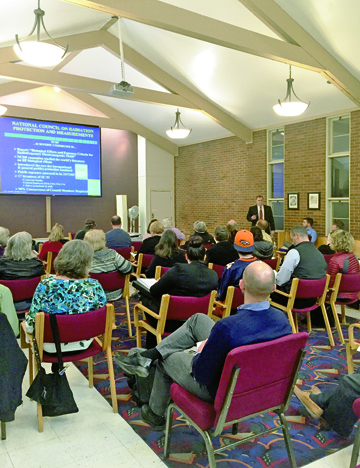 will receive,” he urges.
will receive,” he urges.
Marti Freeman, President of the Cory Merrill Neighborhood Association notes, “What is most interesting about this situation is that the Denver zoning code does not entirely protect residential areas, such as a neighborhood like Cory Merrill, from a 50 foot Tower Structure being placed less than 35 feet from residents property lines.” She wants residents to know that the Kirk of Bonnie Brae Church is zoned residential. Thus Freeman strongly suggests, “Engaging in this negotiation with Verizon is irresponsible and inconsiderate on behalf of the church.” Furthermore she believe the tower on their property in such proximity to neighbors’ homes and backyards, a preschool with a playground plus a major throughway “will create a nuisance for our neighborhood, potential danger, and be aesthetically unappealing potentially diminishing property values in this highly desirable and rapidly developing neighborhood.”
As a final point she tells the Chronicle, “Denver zoning laws should be updated to reflect and meet the needs for great telecommunications services in our residential areas, but not at the expense of our neighborhoods and citizens.” The City of Denver, of course, will review the Verizon request internally and administratively albeit that seldom means a good deal. Approval by the neighborhood association is not required.
Deaf Ear?
Resident Trish Kinkel is even more resolute and adamant: “I do not believe anyone should have the right to construct anything on their property that detrimentally affects the safety, quality of life, and property values of their neighbors.”
She believes the Kirk of Bonnie Brae has turned a deaf ear to their neighbors concerns and continues to negotiate with Verizon. “Come on, a 50 ft tower without an adequate engineered fall zone next to a day care center and existing homes and their own church? It’s all about the money for the church. They don’t care about us,” she concludes.
Area residents haven’t been told a nd the church isn’t saying what Verizon is offering the Kirk to lease the space. Speculation is that the figure is around $1,500 per month. A report by AirWave Cell Tower Consultants reveals that in 2015, “we saw cell sites paying between $100 per year to over $156,000 yearly.” According to the consulting firm, all lease rates regardless of carrier or cell tower developer are site specific and vary from location to location and are based on the demand for coverage and the availability of potential locations to lease ground space, tower space or rooftop space. What is the risk to property owners such as Kirk of Bonnie Brae? “With the possibility of cell phone technology changing (to satellite or other technology), the cell tower company could simply stops paying, they suggest.
nd the church isn’t saying what Verizon is offering the Kirk to lease the space. Speculation is that the figure is around $1,500 per month. A report by AirWave Cell Tower Consultants reveals that in 2015, “we saw cell sites paying between $100 per year to over $156,000 yearly.” According to the consulting firm, all lease rates regardless of carrier or cell tower developer are site specific and vary from location to location and are based on the demand for coverage and the availability of potential locations to lease ground space, tower space or rooftop space. What is the risk to property owners such as Kirk of Bonnie Brae? “With the possibility of cell phone technology changing (to satellite or other technology), the cell tower company could simply stops paying, they suggest.
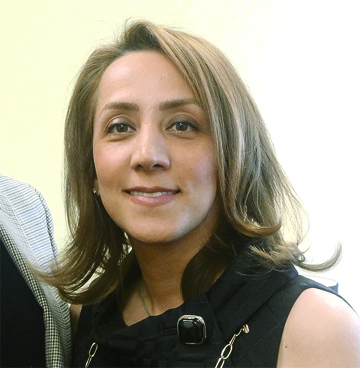
by Mark Smiley | Feb 29, 2016 | Feature Story Middle Left
by Shideh Kerman, B.S., MBA
How healthy are Coloradans in comparison to the rest of the nation? Better grades for children, less so for seniors.
This year’s Colorado health report card was released on Feb. 16, 2016. The Colorado Health Foundation has published the Colorado Health Report Card yearly since 2006. The study provides a benchmark for measuring progress on some of our state’s most important health issues across 38 key health parameters, which are measured through five life stages such as healthy beginnings, healthy children, healthy adolescents, healthy adults and healthy aging.
It offers a glimpse into where Colorado is making headway to becoming a healthier state and critical areas that still need improvement.
In the “Healthy Beginnings” category, which looks at indicators such as prenatal care and childhood vaccination rates, Colorado improved from last year from a C to C+. The main reasons for the bump are an increase in preschool vaccination rates, and decreases in infant mortality and the percentage of expectant moms who don’t get prenatal care.
For the first time since the report card rankings came out, Colorado cracked the top 10 for women receiving timely prenatal care saying only 11 percent now wait until their third trimester for medical care or skip it altogether. The state placed sixth this year up from 41st in 2008.
The state’s children got just a bit healthier last year but still couldn’t muster better than a C+. The reason is we dropped from 14.1 percent of children being uninsured in 2007 to only five percent of children in Colorado who are uninsured today. Decreases in the percentage of children without health insurance had a major effect on improving children’s health. There was little change on the other four indicators, which looked at obesity, physical activity, dental health and medical care.
Teenagers are leading the way toward a healthier Colorado. Teen pregnancies are at a record low in Colorado, with many teenagers reporting they use of protection during sex.
Among teens, “the percentage who were sexually active reached a high of 31.8 percent in 2013, but fell to 23.3 percent in 2016, the lowest rate in the nation,” the report said.
On a related measure, Colorado has nearly halved its teen birth rate in the past decade. Colorado now ranks 18th in the nation, up from 36th.
Now for the bad news: Adults lost their number one spot for most physically active residents, coming in second to Oregon. Colorado adults also lost the nation’s top ranking for diabetes, falling to fourth, as the percentage with the disease rose to 5.3 from 4.5.
Colorado’s seniors grade declined a bit from last year from a A- to B+. Our seniors still score well compared with seniors across the nation but we didn’t do well in areas of receiving the recommended immunizations and flu shots and having a personal doctor.
“Overall, Colorado’s health has improved in the last decade,” said Michele Lueck, the health institute’s president. “We seem to be doing better in the categories of healthy babies and healthy kids.”
Those are among the 10 top achievements cited by the report.
Colorado has tackled arguably its biggest issue by cutting the rate of uninsured residents by more than half from 2013 to 2015. But now it’s time for our officials to turn their attention to the areas that we need improvement like lack of access faced by even the insured to certain services or educating our children to overcome obesity.

by Mark Smiley | Feb 29, 2016 | Feature Story Bottom Left
Here I am, 43-years-old, never been married and I don’t have any kids. When I was 30 that bachelor status was cool, in fact, it was a positive selling point when it came to my bachelor résumé. Now fast forward 13 years. That very same status that I wore as a badge of honor has become “there must be something wrong with this guy.” “He must have commitment problems.” “His window to have kids has closed.” “Greg is going to be a lifelong bachelor.”

How did my superior bachelor status not change, yet go from being cool to creepy? How did my not having baggage turn into BEING my baggage?
Time did it, that’s how. The only thing that changed is I am older now. That’s all, my age has changed. Just like the movie Back to the Future, what kind of advice would the 43-year-old Greg give to the 30-year-old Greg if I could fire up the Flux Capacitor in the ol’ DeLorean and travel back in time?
The answer to that question is… A lot! Here are the top words of wisdom I would offer to my younger self.
- Don’t be Captain Save-a-ho! For some reason I have spent most of my adult life trying to heal wounded women. If there was one time killer that took up a huge chunk of my “viable” years it would probably be choosing to engage with ladies that were in a different period in their life than I.
- Know when to call it good! Uncle, I give up. I wish I would have said that more. I wish I had so much of the time I wasted trying to make bad good. It’s a common mistake. I think people naturally don’t want to just throw something away they have put effort into. In retrospect, I think you will agree it takes much more effort to keep a relationship on life support alive than it is to cultivate a new one.
- Be more selfish! Don’t take this the wrong way. I’m not saying not to be kind to people and be generous, quite the contrary. I am saying stay true to your basic needs, that make you happy and who you are, and don’t let anyone EVER chisel away at that, especially in the name of “love.” True love would always want the best for you and encourage you to find happiness within yourself and allow you to feed the hunger and that which you crave.
- Go get what you want! So often I have been my worst enemy and have sabotaged myself romantically. I know the “type” of woman that would be great for me and I know what I’m attracted to. So why wouldn’t I focus and go get that woman? Probably because when I think about what a great woman that would be I start to doubt that she would want a guy like me. Self-doubt can be a huge stunt to achievement and growth.
- Don’t be afraid to be alone! The pros and cons to being alone. The pros: you are light on your feet, you can be open to a good situation if it presents itself, you don’t have to answer to anyone, and you can date multiple people and see what works best for you. The cons: you’re alone.
- Trust your gut! I’m telling you, gut feelings are usually spot on. If you are in a situation that just doesn’t seem or feel right … it probably isn’t. Don’t waste time on people that have no room in your future.
- Know when you’ve reached Mecca! Grass isn’t always greener on the other side. When you find someone that makes you happy and who promotes your growth in a positive way hold on to them. Life isn’t about giving someone your time; it’s about finding someone you enjoy spending your time with.
It’s crazy how time can work for and against you. Trust me when I tell you it’s better to have time on your side. I know I’m not 100-years-old yet but my window for what I want is narrowing and I never thought it would. I am full on single right now so it should be interesting what the next few years have in store for me. I am going to do everything in my power to be the best person I can be to hopefully attract the kind of woman I desire. The time to date smartly is now, for all of us. Keep it real out there!
Your pal, the Sheik
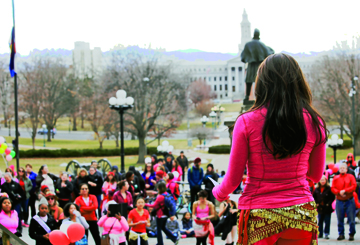
by Mark Smiley | Feb 29, 2016 | Travel
by Megan Carthel
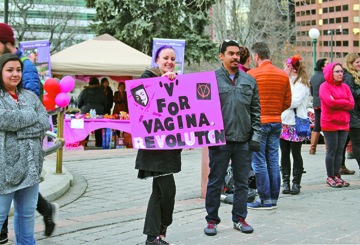 According to the United Nations, one in three women will be beaten or raped in their lifetime, and for the past four years many of those women in Colorado showed up at One Billion Rising, a rally against violence toward women.
According to the United Nations, one in three women will be beaten or raped in their lifetime, and for the past four years many of those women in Colorado showed up at One Billion Rising, a rally against violence toward women.
One Billion Rising is the largest mass action to end and bring awareness to violence against women. The name comes from the statistic of one-in-three. With the world’s population, that totals one billion women who will be beaten or victims of rape. One Billion Rising is leading the initiative to not only make victims survivors, but for violence to no longer be a threat to women.
Each year has had a theme, and this year was centered around the idea of revolution. This year’s rally focused on marginalized women, a call for people to rise for others and international issues such as human trafficking. Here in Colorado, Caitlin Brozna-Smith and her company Bella Diva Dance organized the event. For her, the initiative is personal. Three years ago, just as One Billion Rising was getting started, one of her dancers was almost fatally shot by her ex-fiancé.
“We’re going to rally for our dancer, and we’re going to come together and stand up saying this is not okay,” Brozna-Smith said.
On Valentine’s Day this year, over 200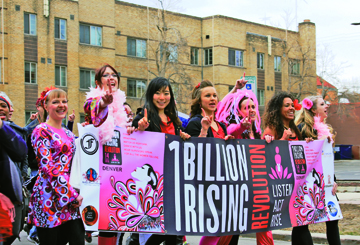 women, men, girls and boys of all ages gathered to hear stories of survivors of rape and domestic abuse. They danced and marched around Denver to raise awareness. Dancing, Brozna-Smith said, is way of expressing unashamed emotion and reclaiming a sense of confidence. Activists and participants across the world dance the same dance on the same day to bring awareness. Brozna-Smith and Bella Diva Dance put a global spin on it, pulling dancing techniques from Bollywood, belly dancing and dance techniques from around the world.
women, men, girls and boys of all ages gathered to hear stories of survivors of rape and domestic abuse. They danced and marched around Denver to raise awareness. Dancing, Brozna-Smith said, is way of expressing unashamed emotion and reclaiming a sense of confidence. Activists and participants across the world dance the same dance on the same day to bring awareness. Brozna-Smith and Bella Diva Dance put a global spin on it, pulling dancing techniques from Bollywood, belly dancing and dance techniques from around the world.
“People are using their bodies because that’s what was violated.”
Bella Diva Dance has been a participant in One Billion Rising ever since one of their own was a victim of domestic violence, but this is Brozna-Smith’s first year heading the rally.
“It’s been very moving in terms of how many people who you actually get to discover this is happening to, and I think it’s something that needs to be talked about more,” Brozna-Smith said.
Tangi Lancaster and her husband Stephan w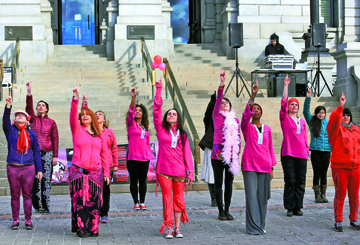 ere both victims of abuse and attended the One Billion Rising rally in Denver. As parents of boys, they feel a need to teach them about body awareness and the power of “no.”
ere both victims of abuse and attended the One Billion Rising rally in Denver. As parents of boys, they feel a need to teach them about body awareness and the power of “no.”
“When they say no, no means no, and I think that starts at a very young age. And we need to engrain that,” Tangi said. “When they do get older and they are around other children who no doesn’t mean no, they can be an advocate, and that’s really why I like to bring them too. So that they know they have a voice, and that they know how to use it.”
For Stephan, he’s there to support his wife and the other billion women who’ve experienced abuse — their entire family wearing matching shirts.
“I know that having my wife at the end of the day having us all dancing together, supporting her, her making these shirts, us all wearing them and me proudly wearing it — I think that’s the part for me that makes me feel good,” Stephan said. “She knows that I’m there for her, and she knows that she’s protected for sure. I would never let anybody ever hurt her again.”
Brozna-Smith wants more men like Stephan to be involved. She said until more men get involved, domestic violence will continue to be a women’s issue. Katee Valverde attended the rally as a victim and survivor. Standing up against violence, toward either gender, is something she feels passionate about.
“I’m here because I’m one in three. I’ve been abused, victimized. I’ve been assaulted. And it’s time to not be quiet anymore,” Valverde said. “It’s too many victims. It doesn’t matter what gender. They’re victims.”
Domestic violence is a prevalent issue around the globe and in Colorado. According to the National Coalition against Domestic Violence, 16,700 people reported at least one domestic violence crime in 2014, and 25 Coloradans were killed by their current or former intimate partners. In a more staggering statistic, the NCADV found that 1,018 people were abducted by current or former intimate partners in 2014, and half of those were abducted by current or former dating partners.

by Mark Smiley | Feb 29, 2016 | Editorials
In the Denver Municipal Election last spring, seven new members were elected to the 13 member Denver City Council. New members Wayne New, Paul Kashmann and Rafael Espinoza were able to win with neighborhood activist support over candidates lavishly funded by real estate developers and lobbyists as well as support from Mayor Hancock. However, conversely Stacie Gilmore and Kendra Black won with strong support from these corrupting elements and are viewed as simply bought and paid for hacks who are never expected to cast a vote other than as instructed by the developers and the Mayor. However, the last two new members, Kevin Flynn and Jolon Clark, while they took developer and lobbyist money, they also had some neighborhood support and were not considered lost causes. Unfortunately none of the six returning council members are viewed favorably by reform groups.
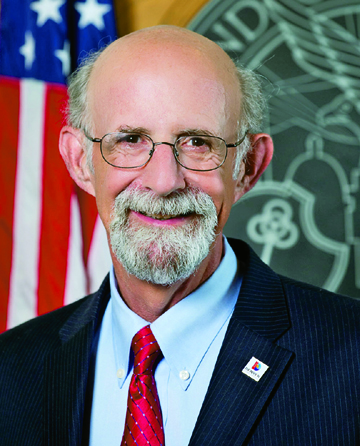
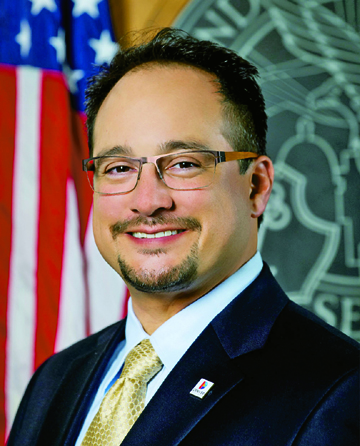
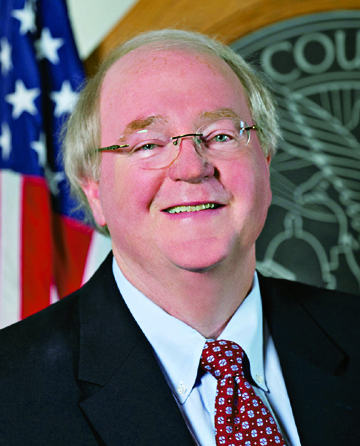
The big question for many was whether New, Kashmann and Espinoza would simply sell out once in office. The preliminary indications after seven months is that they have not and in addition, Flynn and Clark are showing some actual independence from the Mayor’s office on some important votes.
The citizens have even managed to win on a vote about a development project in front of the City Council in large part because it took 10 votes to rezone a property and the proponent Emmaus Lutheran Church managed to get only eight votes. New, Kashmann, Espinoza and Clark all voted “No.” Of course Emmaus Lutheran Church is not a deep pocketed developer like Peter Kudla with an army of lobbyists. Moreover by the old system of so called “courtesy voting” the project would have lost 12 to 0 because the project was in West Highland neighborhood represented by Espinoza. But since the pro neighborhood members were elected the concept has been abandoned regarding their neighborhoods which are some of the most valuable to developers in the city.
It was not an easy vote for the conscientious Espinoza since it involved a church that wanted to transform property zoned for single family homes into a medical facility and not the normal massive apartment high-rise, but he stuck to his principles. Espinoza and Clark even voted against the Mayor’s taxpayer rip off $8.6 million affordable housing bonds that cause the city to lose money while enriching the mayor’s rich backers.
It is at least encouraging that the Denver City Council does have some ethical and honorable members who have to date at any rate not disappointed their backers. So there is still hope in the Queen City of the Plains for the neighborhoods and their honest inhabitants.
— Editorial Board

 as a Congregational Church in 1947 and is affiliated with the United Church of Christ, a mainline Protestant denomination. The name Kirk is the Scottish word for Church, fitting for the neighborhood whose name also has Scottish origin (Bonnie Brae means beautiful hill).
as a Congregational Church in 1947 and is affiliated with the United Church of Christ, a mainline Protestant denomination. The name Kirk is the Scottish word for Church, fitting for the neighborhood whose name also has Scottish origin (Bonnie Brae means beautiful hill). will receive,” he urges.
will receive,” he urges. nd the church isn’t saying what Verizon is offering the Kirk to lease the space. Speculation is that the figure is around $1,500 per month. A report by AirWave Cell Tower Consultants reveals that in 2015, “we saw cell sites paying between $100 per year to over $156,000 yearly.” According to the consulting firm, all lease rates regardless of carrier or cell tower developer are site specific and vary from location to location and are based on the demand for coverage and the availability of potential locations to lease ground space, tower space or rooftop space. What is the risk to property owners such as Kirk of Bonnie Brae? “With the possibility of cell phone technology changing (to satellite or other technology), the cell tower company could simply stops paying, they suggest.
nd the church isn’t saying what Verizon is offering the Kirk to lease the space. Speculation is that the figure is around $1,500 per month. A report by AirWave Cell Tower Consultants reveals that in 2015, “we saw cell sites paying between $100 per year to over $156,000 yearly.” According to the consulting firm, all lease rates regardless of carrier or cell tower developer are site specific and vary from location to location and are based on the demand for coverage and the availability of potential locations to lease ground space, tower space or rooftop space. What is the risk to property owners such as Kirk of Bonnie Brae? “With the possibility of cell phone technology changing (to satellite or other technology), the cell tower company could simply stops paying, they suggest.











